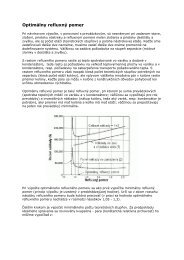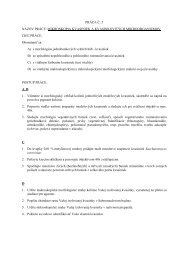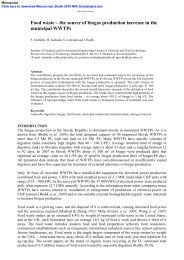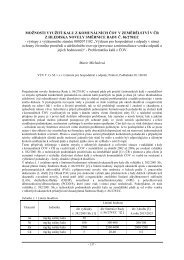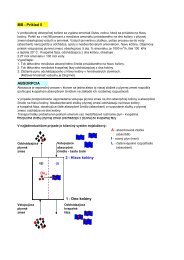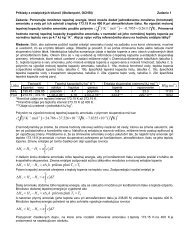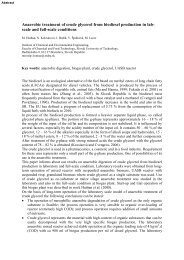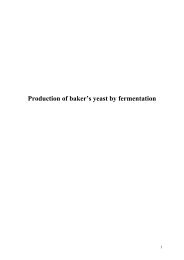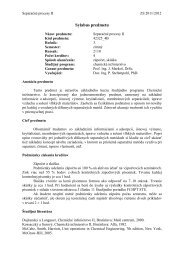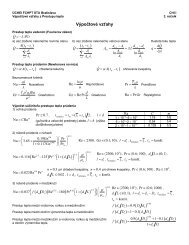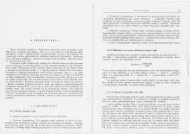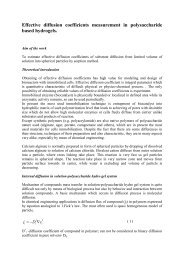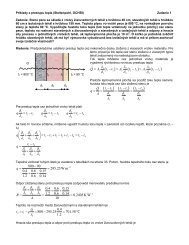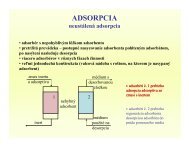The using of enzymes for degradation of cellulose substrate for the ...
The using of enzymes for degradation of cellulose substrate for the ...
The using of enzymes for degradation of cellulose substrate for the ...
Create successful ePaper yourself
Turn your PDF publications into a flip-book with our unique Google optimized e-Paper software.
37th International Conference <strong>of</strong> SSCHEMay 24–28, 2010, Tatranské Matliare, SlovakiaPo-Th-6, 116p.pdfFig. 3. Enzymatic hydrolysisExperiment No. 1 (E1)In <strong>the</strong> first series <strong>of</strong> experiments with compound <strong>of</strong> <strong>enzymes</strong> 5mg <strong>of</strong> <strong>enzymes</strong> were added into 200 ml<strong>of</strong> deionized water. <strong>The</strong> solution was stirred until dissolved <strong>enzymes</strong>. In <strong>the</strong> next step 3 g <strong>of</strong> <strong>cellulose</strong><strong>substrate</strong> were added. <strong>The</strong> temperature was 37°C and mixture wasn’t stirred. Degradation <strong>of</strong> <strong>substrate</strong>to glucose was determined by glucose- oxidation test and by measurement <strong>of</strong> COD values.Experiment No. 2 (E2)In ano<strong>the</strong>r series <strong>of</strong> experiments 50 mg <strong>of</strong> compound <strong>of</strong> <strong>enzymes</strong> were dissolved in 200 ml <strong>of</strong> deionizedwater. <strong>The</strong> solution was stirred until dissolved <strong>enzymes</strong>. In <strong>the</strong> next step 3 g <strong>of</strong> <strong>cellulose</strong> <strong>substrate</strong> wereadded. <strong>The</strong> temperature was 37°C and mixture wasn’t stirred. Degradation <strong>of</strong> <strong>substrate</strong> to glucose wasdetermined by glucose- oxidation test and by measurement <strong>of</strong> COD values.Experiment No. 3 (E3)In final series <strong>of</strong> experiments with compound <strong>of</strong> <strong>enzymes</strong> 450 mg <strong>of</strong> <strong>enzymes</strong> were dissolved in 200 ml<strong>of</strong> deionized water. <strong>The</strong> solution was stirred until dissolved <strong>enzymes</strong>. In <strong>the</strong> next step 3 g <strong>of</strong> <strong>cellulose</strong><strong>substrate</strong> were added. <strong>The</strong> temperature was 37°C and mixture wasn’t stirred. Degradation <strong>of</strong> <strong>substrate</strong>to glucose was determined by glucose- oxidation test and measurement <strong>of</strong> COD values.3. Results and discussionEnzymatic hydrolysis decomposes <strong>cellulose</strong> to cellotetrose and cellobiose in first step. Subsequentlycellotetrose and cellobiose are degradated to glucose, lower aldehydes and ketones (Fig. 4). Products <strong>of</strong>enzymatic hydrolysis depends on <strong>the</strong> type and composition <strong>of</strong> <strong>the</strong> <strong>substrate</strong>, <strong>the</strong> reaction time, <strong>the</strong> typeand quantity <strong>of</strong> <strong>the</strong> <strong>enzymes</strong> and <strong>the</strong> reaction temperature. Glucose itself can be enzymatic degraded toaldehydes and ketones.Compound <strong>of</strong> <strong>enzymes</strong> was used <strong>for</strong> <strong>the</strong> <strong>degradation</strong> <strong>of</strong> cellulosic <strong>substrate</strong>. Time dependence <strong>of</strong>glucose production resulting from <strong>substrate</strong> <strong>degradation</strong> is shown in figure 5. From each experiment isappeared that <strong>the</strong> production <strong>of</strong> glucose is affected by <strong>the</strong> amount <strong>of</strong> <strong>enzymes</strong> used, quantity <strong>of</strong><strong>substrate</strong>, reaction temperature and time. <strong>The</strong> highest glucose yield was achieved in <strong>the</strong> experiments no.3. In experiment No. 2 and 3. a decrease in glucose concentration after 24 hrs. was observed, whichwas caused by <strong>the</strong> amount <strong>of</strong> used <strong>enzymes</strong> (Tab. 1, Fig. 4).1409



